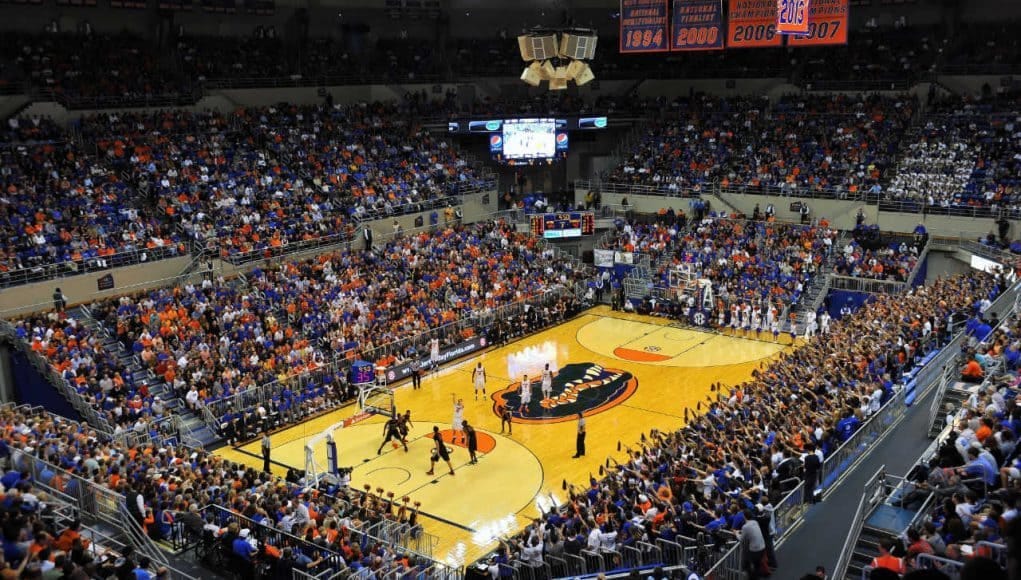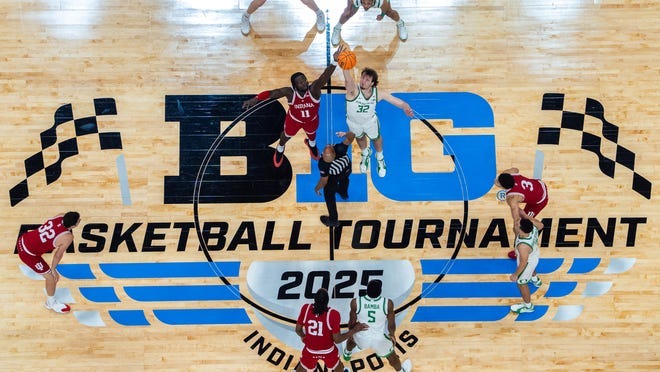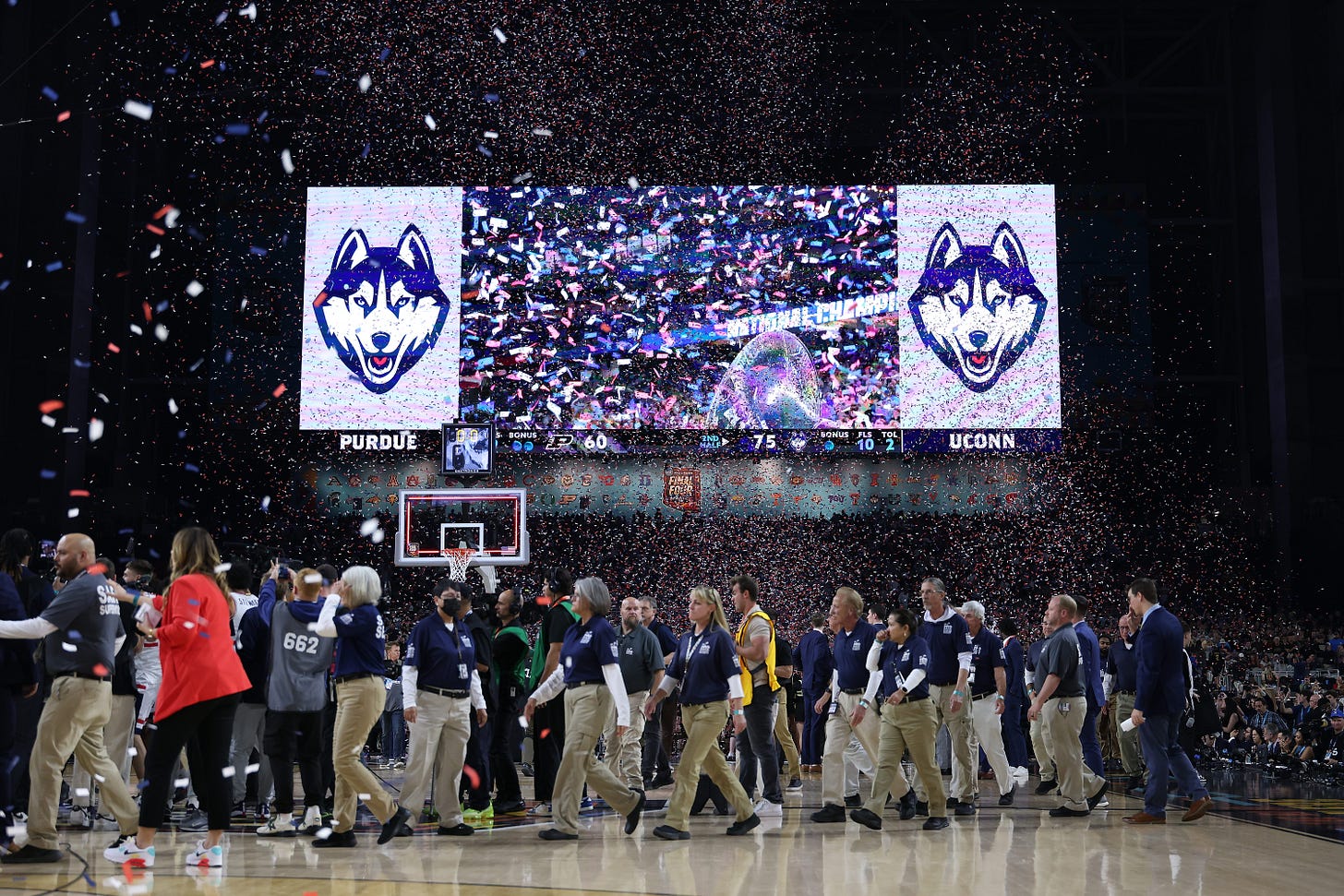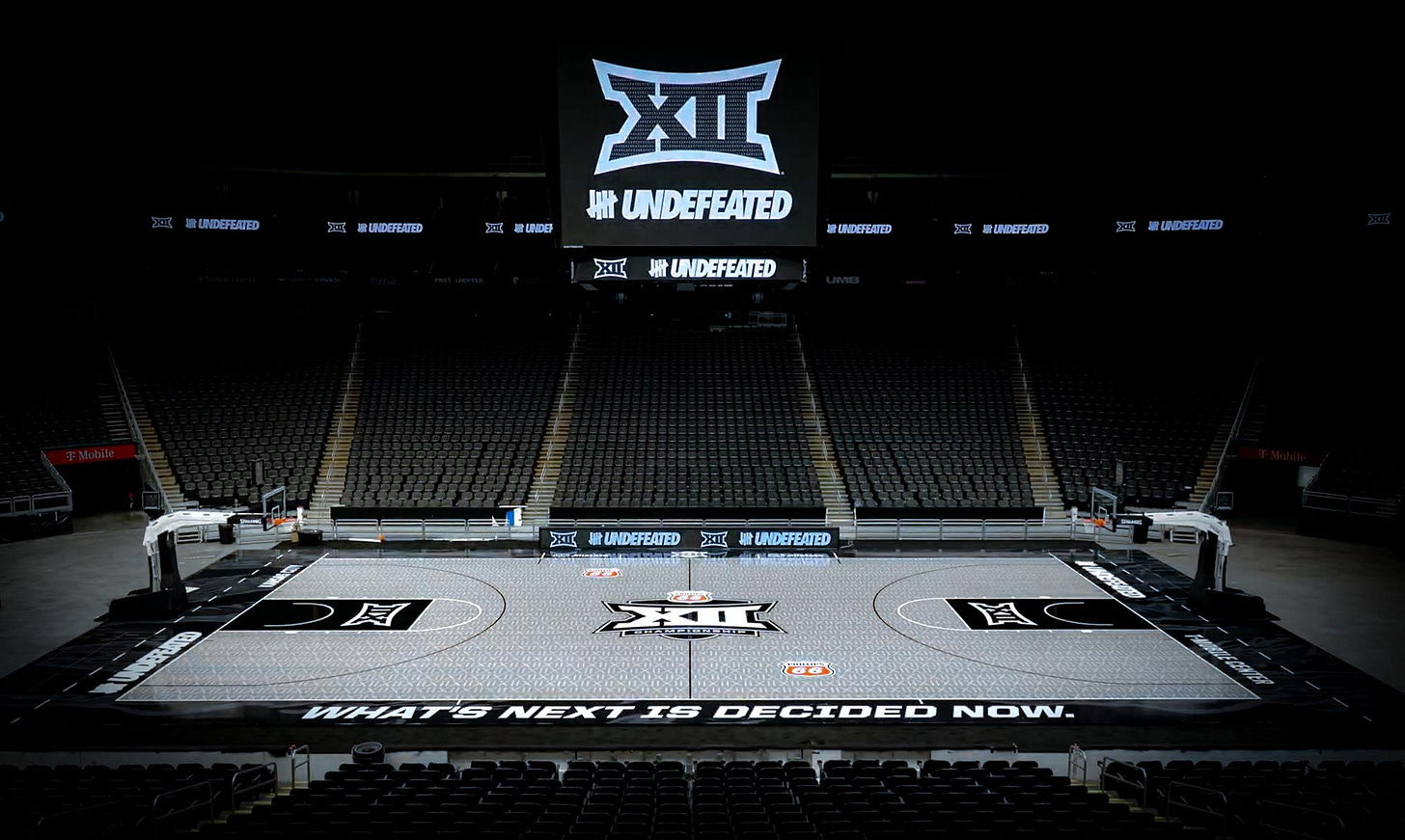What happens the year after you break records?
On the SEC's (and Big Ten's?) odds to follow up a historic 2024-25 campaign
As early as December 6, 2024, I thought we might have history in the making.
This isn’t some sort of horn-tooting escapade in the midst of an abnormally long May; rather, just a note that we had a pretty seismic shift this past year as it pertains to college basketball. For the first time since 2002-03, the SEC was the nation’s best basketball conference, per KenPom. Obviously, the conference had some impressive runs in its past - two Final Four teams in 2006 and 2014, four Sweet Sixteen teams in 2019 - but largely, when you think SEC, you think football.
For most of the last 15 years, when you think college basketball, you think the Big 12 and the Big Ten. Laugh at the Big Ten’s title drought as you must, but from 2010 through 2024, the Big 12 (10) and the Big Ten (five) rotated the title of Best Basketball Conference in America at KenPom. No one else got a turn at the top.
Across college hoops history, we haven’t had much in the way of comparable dominance. In the 2000s, the ACC technically ruled the roost, but they held a plurality (four times) of BBCiA titles, not a majority. The 2000s were quite diverse in that every major conference had their shot at the top: the ACC (2001, 2004, 2005, 2007), Big Ten (2000), Big East (2006), SEC (2002, 2003), and even the departed Pac-12 (2008, 2009). (Yes, the Big 12 never touched the top.) Even in the 1990s, when the ACC and Big Ten ruled college basketball, the then-Big Eight owned 1991 and 1992, per Stathead.
Basically, at least in my lifetime and in almost anyone reading this’s lifetimes, we hadn’t had a decade-plus across history where it was functionally two conferences and everyone else. March plays a major factor on how we recall conference performance over time, but during that 15-year run, the Big Ten (93) and Big 12 (91) but the most teams in the NCAA Tournament, were responsible for 38 of the 112 1 and 2 seeds handed out, and owned 15 of the 56 Final Four teams. Could they have done more? Yeah, probably. (The ACC won more games than either.) But in terms of sustained November-to-April performance, no one touched these two.
Besides, if you figured any conference would threaten, it probably wasn’t the SEC during this stretch. A 2022 second-place finish was the conference’s first top-3 run nationally since 2007, and a 4th-4th-2nd-4th run from 2021 through 2024 was merely the conference’s first four-year run of top-four finishes since 2001 through 2004. The average person’s first image of SEC is less this:
And more this.
And yet: in 2024-25, the SEC set a new record. With an average AdjEM of +22.09, the SEC had the single best season in KenPom’s 29-year database of any conference. Going further back in history, I couldn’t find one to match their success. There’s a good likelihood that this was the best conference-wide performance ever.
I figure you probably knew this, though. The SEC dumping 14 teams into the 2025 NCAA Tournament smashed the previous high of 11, and much ink was spilled about the Greatest Season Ever. They even beat Ken’s own expectations, which were…less high than others, I guess.
Obviously, it’s not easy to craft a masterpiece. It took the Beatles until their 11th album to craft Abbey Road. Led Zeppelin needed four, and countless years of work prior, to make their presumed best. 2001: A Space Odyssey was Stanley Kubrick’s eighth movie, 16 years into his career. The SEC didn’t get here overnight; they made a lot of moves, both obvious and not-so-obvious, that got them to this height.
The problem is that a masterpiece rarely becomes masterpieces. You’re lucky to get one; it’s borderline impossible to make a second. That’s where the second half of the above table, and the gist of our article, comes in.
Of the nine previous conferences to hit an 18+ AdjEM (now Net Rating) or above, every single one saw a decline in performance the next year. (I grandfathered in the ‘22-23 Big 12 at +17.99. It’s close enough.) In fact, seven of the nine saw a decline of two points or worse, with the average decline being -3.08 points in the next season.
Now, the SEC was so historically outstanding that a 3.08-point decline would still result in them having a top-five season of the last 30 years in ‘25-26, and even a four-point drop-off would still give them the 12th season on record with an 18+ average Net Rating amongst their conference members. All of that’s pretty good. However, you may have noticed there’s another 2024-25 entry on this list.
The 2024-25 SEC represented four of the six best teams, including the future national champion, at KenPom. They were a level ahead of everyone else. And yet, in what should really hammer in the concept of 2024-25 being one of the highest quality seasons of college basketball we may ever see, the Big Ten also got to be one of the five best conferences, at least over the last 30 years. The Big Ten didn’t place a single team in KenPom’s top five, but they dumped seven in the top 21 and 12 in the top 50. Collectively, the SEC and Big Ten made up 15 of the top 25 and 26 of the top 50. It was a two-conference year, just like it sort of used to be.
Except this time around, it’s a lot different. Obviously. The SEC, after endless realignment machinations, now has 16 teams with the presumed capability to add more going forward. The Big Ten has 18. In modern college basketball history, we’ve never seen conferences this large take up this much room of the top end of the basketball landscape. Still, there is real skill involved in adding all these teams. If you add a bunch of crap, you’re going to get worse on average. Just ask the ACC, who has more teams than ever yet delivered its fourth-worst season of the last 50 years at Stathead.
That’s why there’s no case-by-case breakdown here for these conferences as they add and add. No one else, across history, has really had to build on a historical run with this many teams. There’s only two examples of conferences with more than 12 teams either in their peak year or the year after: the 2021-22 Big Ten and the 2023-24 Big 12, both of which had 14 teams and had to plunder other power(ish) conferences for their additional resources.
After a tremendous COVID year that saw the Big Ten represent five of the top 14 teams nationally and only deposit four of its 14 members outside of the KP top 50, the conference fell back to third in 2021-22 with about a two-point drop-off in production. Why? Well, pretty simple: non-conference production, which was so small (just 81 games of data) in 2020-21, swung back to norms in 2021-22.
2020-21 Big Ten, non-conference games (81): +10.6% 2PT (54.7% offense, 44.1% defense), +5.3% 3PT (36.9% to 31.6%)
2021-22 Big Ten, non-conference games (139): +9% 2PT (53.7% offense, 44.7% defense), +4.3% 3PT (35.5% to 31.2%)
While this is over-simplifying it and much more goes into various ratings machinations - read here - this, which would roughly account for a 2-3 point drop-off, can explain why the Big Ten took a minor step back. Even with what was actually a significantly softer overall schedule in ‘21-22 due to more normal, scheduled games getting played, they didn’t outshoot opponents by quite as much as they did the winter before in a smaller dataset.
The same could be said of the Big 12 and its ‘22-23 follow-up in ‘23-24. Actually, their case gets easier to decode when all Quadrant 4 games are removed. (We can do this because in 2022-23 and on, COVID has almost entirely stopped cancelling or postponing games.)
2022-23 Big 12, Quad 1-3 non-conference games (67): +1.7% 2PT (51.5% offense, 49.8% defense), +3.4% 3PT (34.5% to 31.1%)
2023-24 Big 12, Quad 1-3 non-conference games (83): +2.1% 2PT (50% offense, 47.9% defense), +1.7% 3PT (34.9% to 33.2%)
The 3PT% figures here are what I’d like to note. In an average season amongst the high-major leagues, it’s actually pretty rare for a league to touch that +3% 3PT barrier in Quad 1-3 games. Prior to the Big 12 doing it in 2022-23, it hadn’t happened since the 2018-19 Big Ten did it (+3.2%), and the +3.4% figure was the highest since a pretty shocking +5.3% run by the ACC in 2016-17. (These things do matter. In 2016-17, the ACC had four of the top 12 teams in the NCAA Tournament despite three of the four having six or more conference losses.)
Anyway, all of that comes into play for the following reason.
Highest 3PT% disparities in non-conference play, 2024-25
SEC (+5.5%)
Big Ten (+4.8%)
Conference USA (+4.1%)
Actually, Jamie, drill down a bit for me on that one.
Lowest 3PT% allowed in non-conference play, 2015-present
2014-15 ACC (29.4%)
2021-22 Big 12 (29.5%)
2024-25 SEC (29.7%)
2022-23 Big 12 (30.0%)
2024-25 Big Ten (30.1%)
As we know and have discussed ad nauseum for a decade now, opposing 3PT% is a little bit of skill and a whole lotta bits of noise. In the last 11 seasons, there’s been six conferences total to hold opponents to 30.3% or lower from deep (the 2015-16 ACC being the sixth). Until 2024-25, we hadn’t seen two in the same season, particularly from two conferences that A) each posted their record-low opponent 3PT% in this 11-year span and B) were so far clear of the rest of the pack that it was fairly amazing.
Lowest 3PT% allowed in non-conference play, 2024-25
SEC (29.7%)
Big Ten (30.1%)
Conference USA (31.5%)
WCC (32.1%)
…
T-16. MVC and Big West (33.3%)
(NOTE: Yes, there was the same gap from #1 to #3 as there was from #3 to #16.)
This was all while adding teams that, for the most part, had no serious effect on either’s season. Texas and Oklahoma finished 13th and 14th in the SEC. The B1G’s four new entrants finished 4th, 8th, 14th, and 18th. Is it possible that the SEC and Big Ten, even while adding completely new teams with new styles, have somehow solved three-point defense, whether by way of athleticism or analytics? Sure, it’s possible. Is it more likely that each were beneficiaries of unusually weak opponent deep shooting over the span of roughly 6-7 weeks of basketball? I think so.
Now, this shouldn’t diminish either conference’s amazing 2024-25 run. Subsuming other conferences is one thing, but again, writers like myself should do a better job of noting that the programs themselves have done the job of simply getting better coaches, spending more money on basketball, and building more talented rosters. They combined for 36 Tournament wins (the other 29 conferences, total, had 27) and 11 of the 16 Sweet Sixteen teams. I don’t have to like it, and I don’t, but I do report facts or at least attempt to.
Still, it’s simple logic. Even the very, very best among us find it incredibly hard to top our magnum opus. If the SEC cannot top 2024-25, and history suggests it almost certainly cannot, that’s fine. It’ll probably still be very good. The same goes for the Big Ten, who had less star power but some remarkable depth. And, as usual, we should probably remember the real kings of the last 15 years of basketball before we hand it all over to our new mega-conference, football-brained overlords.
No, not you! The other ones.
Six months from now, I’m sure they’ll have something to say about our supposed seismic shift. I just hope they come up with something better to say than “what’s next is decided now.” What in Deloitte’s name could that possibly mean?







